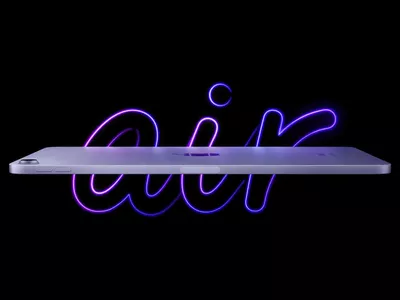
New Multiple Ways How To Remove iCloud Activation Lock On your iPhone 14

New Multiple Ways: How To Remove iCloud Activation Lock On your Apple iPhone 14
Undeniably, one of Apple’s selling points is its focus on security. iPhones, iPads, Macs, and other Apple stuff all enjoy this robust security system. Of course, this is mainly made by Apple through iCloud or Apple ID. This system is designed to protect your data and prevent unauthorized access. This is what makes Apple’s devices highly secure and sought after.
However, a common challenge arises when you acquire a second-hand iPhone or iPad. You may find it’s connected to the previous owner’s iCloud account through an Activation Lock. This situation can be a significant hurdle, rendering the Apple iPhone 14 device almost unusable. As you may expect, this article will help you remove the iCloud Activation Lock.

Part 1. What Is the iCloud Activation Lock
The iCloud Activation Lock is a security feature unique to iOS. It’s intended to prevent people from accessing or resetting stolen devices. This feature is automatically enabled when “Find My iPhone” is turned on and effectively locks the Apple iPhone 14 device to a specific Apple ID.
Attempting To Remove iCloud Activation Lock
Simply logging in with the correct Apple ID credentials will suffice to overcome this lock under normal circumstances. This process is straightforward if you are the original owner and remember your login details. However, there are instances where it could be more. You might forget your Apple ID, buy a second-hand device still linked to the previous owner’s account, or inadvertently reset your phone and face the iCloud Activation Lock.
In these situations, you’re left with a virtually unusable device. But there’s no need to panic. Several methods exist to bypass or remove the iCloud Activation Lock, even when the original Apple ID is unknown or forgotten. In the following sections, you’ll explore these methods. You’ll find step-by-step guidance to remove the iCloud Activation Lock to enjoy its full functionality.
Part 2. Method 1: Remove iCloud With Apple ID Password
If you’re fortunate enough to know the Apple ID associated with the Apple iPhone 14 device, learning how to remove iCloud Activation Lock is straightforward. This method is ideal for those who have either forgotten their password or acquired a second-hand device still linked to the previous owner’s Apple ID but have their cooperation in unlocking it.
If you see the Activation Lock screen, it means the Apple iPhone 14 device is still tethered to an Apple ID. Follow the onscreen instructions to input the Apple ID and password initially used to set up the Apple iPhone 14 device. If the Apple iPhone 14 device has a passcode, you may also use that for unlocking. Then, you can remove the old Apple ID by going to Settings > Tap on the profile on top of the app > Sign Out.

If you’ve forgotten your Apple ID, it can be recovered by signing in with your Apple ID account. Then, click the Forgot Password button. You may need to answer security questions or receive a code on a trusted device to complete this process.
Removing Activation Lock via iCloud (For Offline Devices)
Alternatively, you can remove the iCloud account by following the steps below. You can ask the original owner to do this or do it independently if you can access the account.
- Step 1: Go to <www.iCloud.com/find> on any web browser.
- Step 2: Log in with your Apple ID (or the Apple iPhone 14 device owner’s ID) and password.

- Step 3: From the list of devices associated with this Apple ID, select the one you wish to unlock.
- Step 4: Click Remove from Account. This action will disassociate the Apple iPhone 14 device from the Apple ID, removing the Activation Lock.
Following these steps, you can remove the iCloud Activation Lock from your device, provided you can access the necessary Apple ID credentials. This method is the most secure and straightforward way to regain access to your device without compromising your data or the Apple iPhone 14 device’s functionality.
Part 3. Method 2: Remove iCloud Without an Apple ID Code in a Few Clicks
Third-party tools like Wondershare Dr.Fone provide an effective solution when you can’t access the Apple ID passcode. Dr.Fone is recognized as an all-in-one mobile solution, catering to various needs beyond unlocking devices. It has features like recovery, system repair, data transfer, backup and restore, and Screen Unlock (iOS).
The Screen Unlock feature is valuable for bypassing the iCloud Activation Lock without needing the original Apple ID passcode. It’s a useful tool for those who have bought a second-hand device still tied to the previous owner’s Apple ID or have forgotten their Apple ID details.
Read the steps below to learn how to use the Screen Unlock feature to remove the iCloud Activation Lock.
Method 2.1: Removing Apple ID Without Jailbreak
First, Dr.Fone’s Screen Unlock can remove the iCloud Activation Lock without jailbreaking the Apple iPhone 14 device. Note that this only works when the phone is not in activation mode. This can be any time before the phone is reset. The steps below guide you how to remove the Apple ID from the Apple iPhone 14 device.
Step 1: Download and install Wondershare Dr.Fone from the official website.
Step 2: Open Toolbox > Screen Unlock > iOS.

- Step 3: Choose Remove Apple ID on this page.

- Step 4: Connect your phone to the computer. A verification message should appear. Then, click Unlock Now.

- Step 5: Verify if your phone has two-factor authentication enabled on this page. Follow the onscreen instructions.

- Step 6: Dr.Fone will give instructions on how to put your phone in Recovery mode. If it doesn’t work, click DFU Mode at the bottom of the screen.

- Step 7: Wait for the download of the firmware.

- Step 8: After verifying the firmware, click Unlock Now. Type in “000000” on the text box when the prompt appears.

- Step 9: Wait for the process to finish. Then, check if the iCloud account is removed through Settings. If not, click Try Again.

Method 2.2: Bypassing iCloud Activation Lock (Jailbreak Method)
If your device is on the activation screen, the above-presented method will not work. This is where you’ll have to jailbreak your device and bypass the iCloud Activation Lock with Dr.Fone. It might seem daunting. Don’t worry, as Dr.Fone will be guiding you through this. Just follow the steps below:
- Step 1: Go to Toolbox > Screen Unlock > iOS.

- Step 3: This time, choose iCloud Activation Lock Removal.

- Step 4: Click Start.

- Step 5: When Dr.Fone prompts you to connect your Apple iPhone 14, use a cable to connect it to your computer.
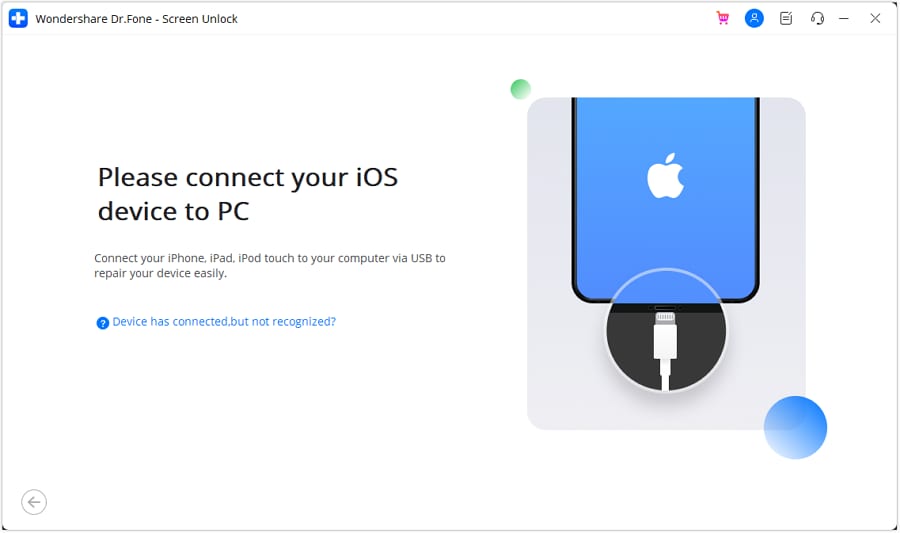
- Step 6: To identify if your phone is GSM or CDMA, navigate to Settings > General > About. If it’s CDMA, cellular/SIM functions won’t work, but other features remain usable. Upon selecting Unlock Now, a warning pop-up appears. Confirm by clicking Got it.

- Step 7: At this part, you should jailbreak your device. Click JailBreak Guide or Watch Video to be guided on the process.
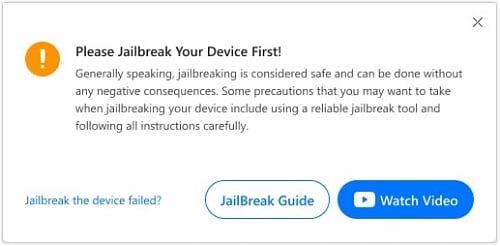
- Step 8: Dr.Fone will automatically begin the bypassing process after jailbreaking the Apple iPhone 14 device.
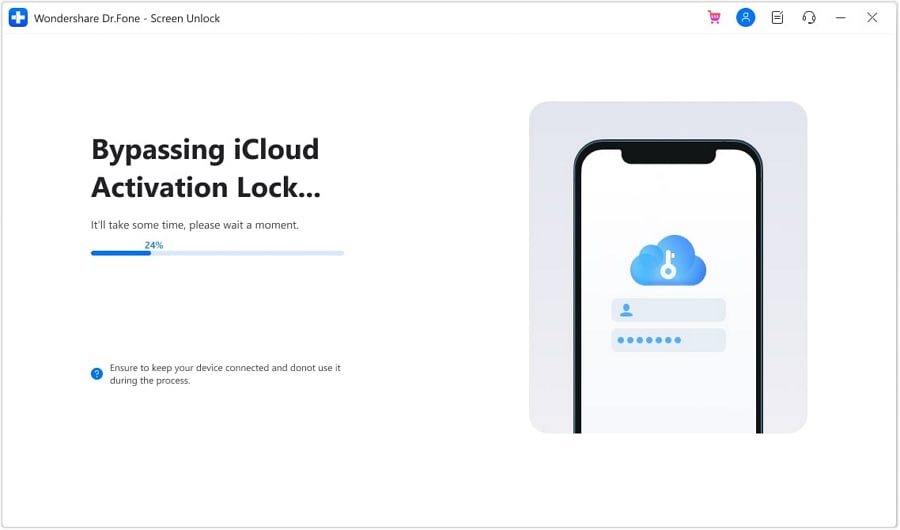
- Step 9: After the process finishes, click Done.

Part 4. Method 3: Use Dedicated Third-Party Services To Remove iCloud Lock
Numerous dedicated third-party services, such as IMEICheck.co and iUnlocker.com, offer activation lock removal for those seeking alternative solutions. These websites typically work by using the Apple iPhone 14 device’s IMEI number to unlock the associated iCloud account.
Users visit these websites, enter their device’s IMEI number, and request the iCloud unlock service. Depending on the service provider, these platforms process the unlock request, which can take a few days. While convenient, users should exercise caution and ensure they’re using reputable services to avoid potential scams.
Conclusion
In summary, removing iCloud Activation Lock can be crucial for those dealing with locked Apple devices. This article has explored several methods: using the Apple ID password, leveraging the capabilities of Dr.Fone for those without the password, and opting for third-party services.
It’s important to remember that these methods should only be used for legitimate purposes, such as unlocking a device you legally own. Dr.Fone remains a recommended tool for a comprehensive mobile solution, particularly for unlocking needs.
Tips: Are you searching for a powerful Unlock tool? No worries as Dr.Fone is here to help you. Download it and start a seamless unlock experience!
How To Fix Apple iPhone 14 Could Not Be Activated/Reached Issue
Are you struggling with your Apple iPhone 14’s activation? The Apple iPhone 14 activation process is crucial for seamless functionality, but encountering issues like ‘iPhone could not be activated’ can be frustrating. In this guide, you’ll learn how to simplify the process of iPhone activation, shedding light on common problems that users face.
From understanding error messages to the significance of swift resolutions, this article has got you covered. Let’s navigate through these activation errors to ensure your Apple iPhone 14 is activated smoothly. Because when it comes to your device, prompt problem-solving is the key to a hassle-free experience.

Part I. Explanation To Common Apple iPhone 14 Activation Errors
Are you greeted with puzzling messages like “iPhone could not be activated” when setting up your device? Let’s demystify these common errors and get your Apple iPhone 14 up and running smoothly.

A. Common Apple iPhone 14 Error Messages
Check out below the most common error messages iPhone users might encounter:
- “iPhone could not be activated”
This message often pops up during a hiccup in the activation process. It could be due to various reasons, but fear not – solutions are within reach.
- “Activation server cannot be reached”
Imagine your Apple iPhone 14 trying to connect to the activation server but facing hurdles. This error signifies a connection issue, hindering the activation process.
- “Activation lock server cannot be reached”
This error may sound complex, but it often boils down to a connectivity glitch with the activation lock server. Discover straightforward steps to address this and unlock the activation process.
B. Causes Behind These Errors
Now learn about the causes behind these reasons by reading below:
- Activation Information Issues
Sometimes, the activation information your Apple iPhone 14 receives may be incorrect or incomplete. This could be due to a typo in your Apple ID or an issue with iCloud credentials. We’ll guide you through double-checking and correcting these details.
- Server-Related Problems
Your iPhone communicates with servers during activation. If there’s a hiccup in this interaction – for instance, the activation server or activation lock server cannot be reached – it can result in errors. We’ll explore troubleshooting steps to ensure seamless server connectivity.
Understanding these common errors and their causes is the first step to resolving them. In the next sections, you’ll delve deeper into troubleshooting methods and practical solutions to activate your Apple iPhone 14 without a hitch. Stay tuned for a hassle-free iPhone experience!
Part II. How To Fix iPhone Activation Errors
So, you’ve encountered the frustrating activation information showing the “iPhone could not be activated” message. No worries! Let’s dive into practical solutions that will have your Apple iPhone 14 activated in no time. Follow these easy troubleshooting methods, and say goodbye to activation problems.

Checking Network Connectivity
First things first – ensure your Apple iPhone 14 is well-connected to the internet. Activate Wi-Fi or cellular data and try the activation process again. A stable connection is the cornerstone of a successful activation.
Verifying Apple ID and iCloud Credentials
Activation errors might stem from a small typo or a forgotten detail. Double-check your Apple ID and iCloud credentials. Confirm that you’re using the correct email and password. Accurate information is key to a smooth activation.
Ensuring Server Availability
Activation involves communication with servers. If the activation server or activation lock server cannot be reached, your Apple iPhone 14 may face hurdles. Confirm that Apple’s servers are up and running smoothly. You can do this by checking Apple’s system status page online.
Following these straightforward steps addresses common activation glitches. But what if the issue persists? In the next section, you will be introduced to an effective tool that goes beyond traditional troubleshooting methods. Stay tuned to discover a hassle-free way to unlock your Apple iPhone 14’s full potential!
Part III. Still Facing Errors? Your Lifesaver: Dr.Fone - Screen Unlock (iOS)
Despite your best efforts, some iPhone activation issues persist, leaving you stuck in frustration. When traditional troubleshooting falls short, it’s time to introduce a reliable ally: Wondershare Dr.Fone - Screen Unlock (iOS). This tool emerges as a lifesaver, offering a seamless solution to activation challenges.
Dr.Fone - Screen Unlock (iOS) is not just a tool; it’s a lifeline for those struggling with persistent activation errors. Tested and trusted, it goes beyond conventional methods, ensuring you regain access to your device effortlessly.

Key Features and Benefits
These key features and benefits below collectively contribute to making Dr.Fone - Screen Unlock (iOS) a comprehensive tool for addressing various iPhone-related challenges.
- Dr.Fone - Screen Unlock (iOS) is compatible with a large number of iPhone models, ensuring that users with different devices can benefit from its features.
- The tool prioritizes the security and privacy of user data. It employs advanced encryption protocols to safeguard sensitive information during the unlocking process.
- Beyond activation issues, Dr.Fone - Screen Unlock (iOS) can handle various other scenarios, such as unlocking a forgotten passcode, bypassing the Apple ID, and recovering data from disabled devices.
- **No Data Loss.**One of the standout features is its ability to unlock the Apple iPhone 14 device without causing any data loss. Users can regain access to their iPhones without compromising their valuable information.
- **Time Efficiency.**Fone - Screen Unlock (iOS) offers a quick and efficient solution. Users can save time compared to troubleshooting methods that may take longer without guaranteed results. Dr.Fone efficiently activates your Apple iPhone 14, putting the control back in your hands.
- **Risk Mitigation.**The tool minimizes the risk associated with attempting various troubleshooting methods. It provides a straightforward and less risky alternative to ensure successful iPhone activation.
- **Intuitive Interface.**Fone boasts an intuitive and user-friendly interface, making it accessible to individuals with varying levels of technical expertise. Users can navigate through the unlocking process seamlessly.
- **Reliable Results.**Count on Dr. Fone’s proven track record. It’s a reliable choice when traditional troubleshooting methods fall short.
Step-by-Step Guide
Learn how to use Dr.Fone – Screen Unlock (iOS) as an alternative tool to fix iPhone activation errors. The method provided below will not require jailbreaking the phone and supports devices running on iOS 15.0 to 16.3 (iPhone 6/6 Plus, iPhone 6S/6S Plus, iPhone 7/7 Plus, iPhone 8/8 Plus, iPhone X).
- Step 1: Get the most recent version of Wondershare Dr.Fone installed on your computer, then run the program. Navigate to Toolbox, click Screen Unlock, then select iOS. In the next screen, choose iCloud Activation Lock Removal.

- Step 2: When prompted, choose Start to begin unlocking the Activation Lock on your iOS device.

- Step 3: You will be asked to connect your iOS device to a USB cable while propagating into the corresponding function. The window will show the status as you connect the Apple iPhone 14 device and will immediately bring you to the next screen.

- Step 4: Once on the next screen, double-check all the information related to the iOS device and click the Unlock Now option.
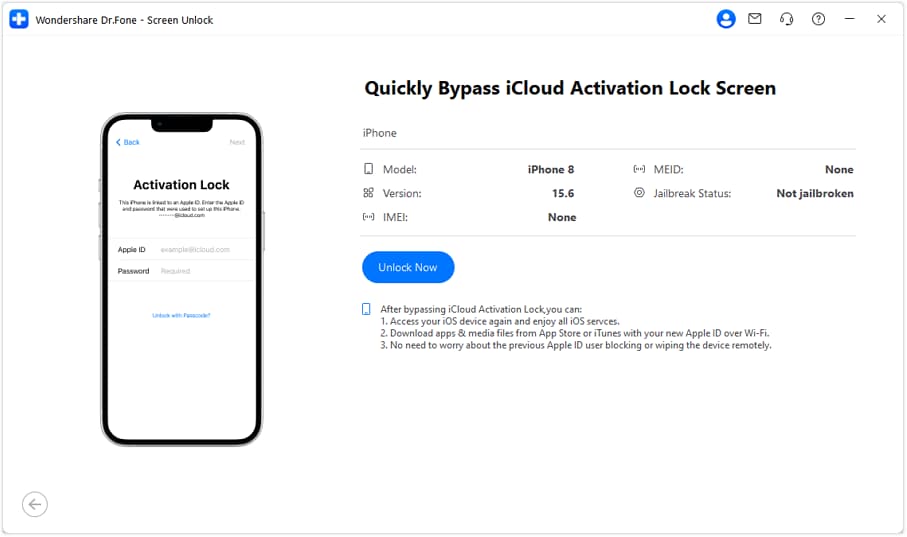
- Step 5: The next step is for a warning prompt to show up on the screen, indicating that the user should be aware of the procedure. Please read the agreement carefully and indicate your agreement by checking the appropriate box. Click the Got It! button to proceed.
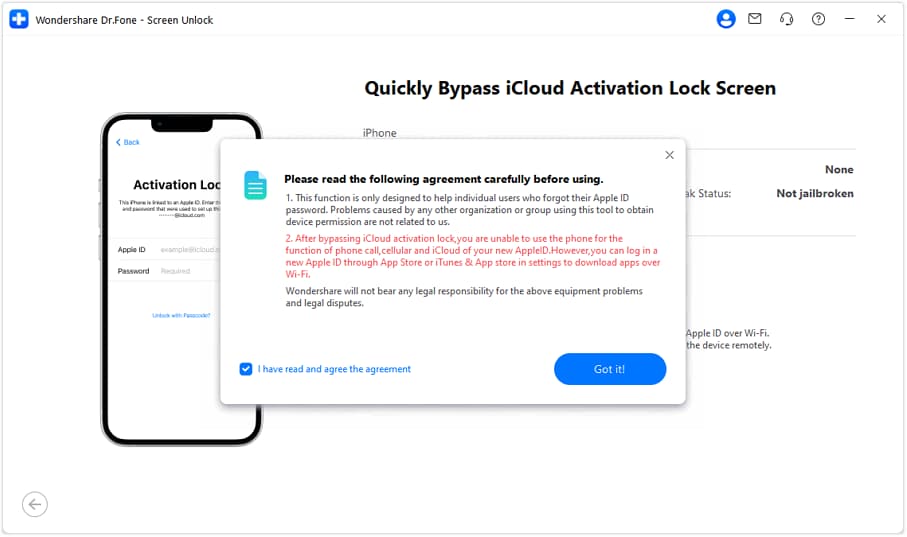
- Step 6: Follow the on-screen prompts to enter DFU Mode on your iOS device. Upon initialization of the Apple iPhone 14 device in DFU Mode, the program initiates a restart process by sending a command to the Apple iPhone 14 device. Press the “right arrow” to proceed.
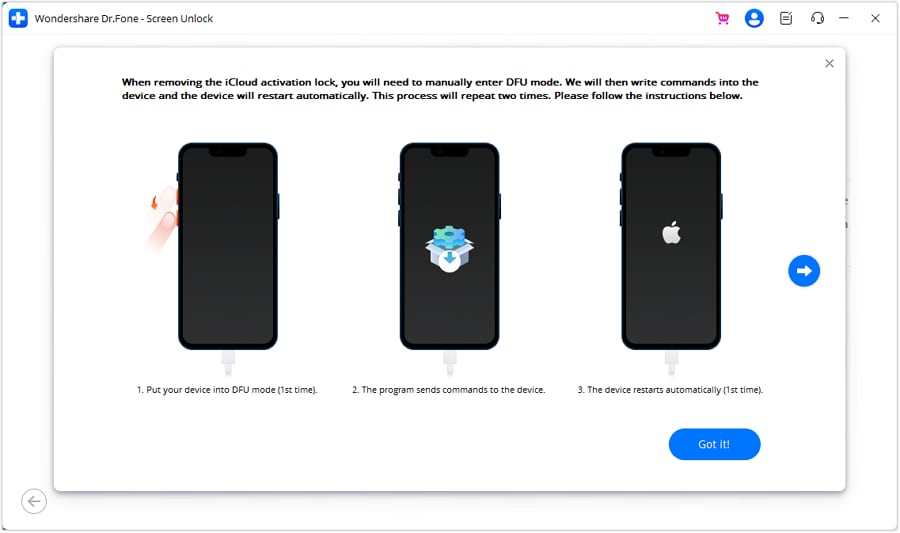
- Step 7: Continue to set the iOS device to DFU Mode for the second time. As a result, the program activates and unlocks the gadget. When it is finished, click the Got It! button to finish.
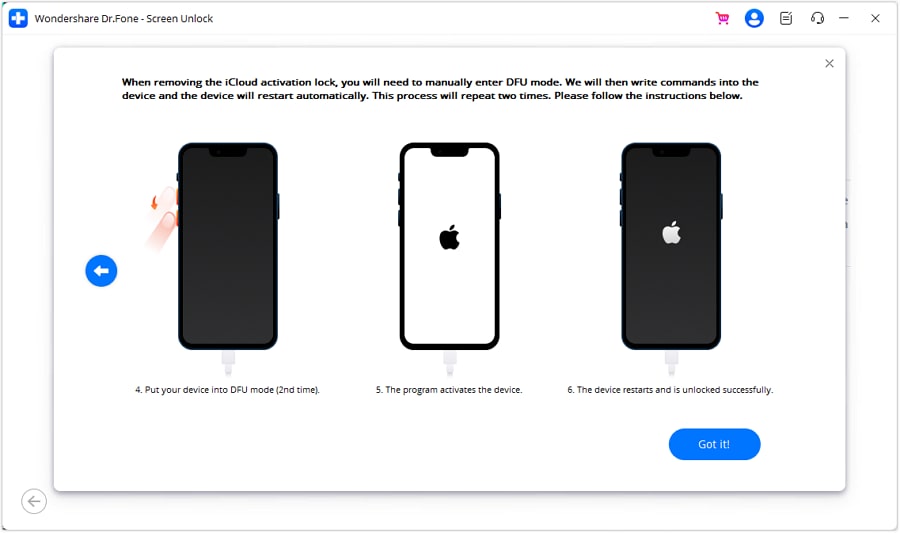
- Step 8: When the platform does not recognize a device, users must follow the on-screen instructions to enter DFU Mode on their iOS device.
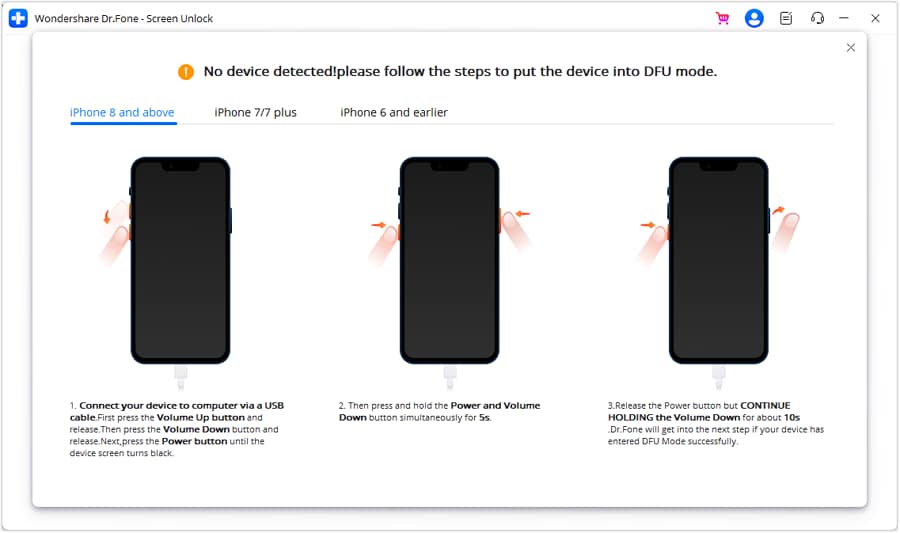
- Step 9: After the Apple iPhone 14 device has been processed in DFU Mode, you will be able to see the iCloud Activation Lock being removed from your computer’s screen. The screen will show a completion message once it’s done. To complete the process of removing the iCloud Activation Lock, click Done.
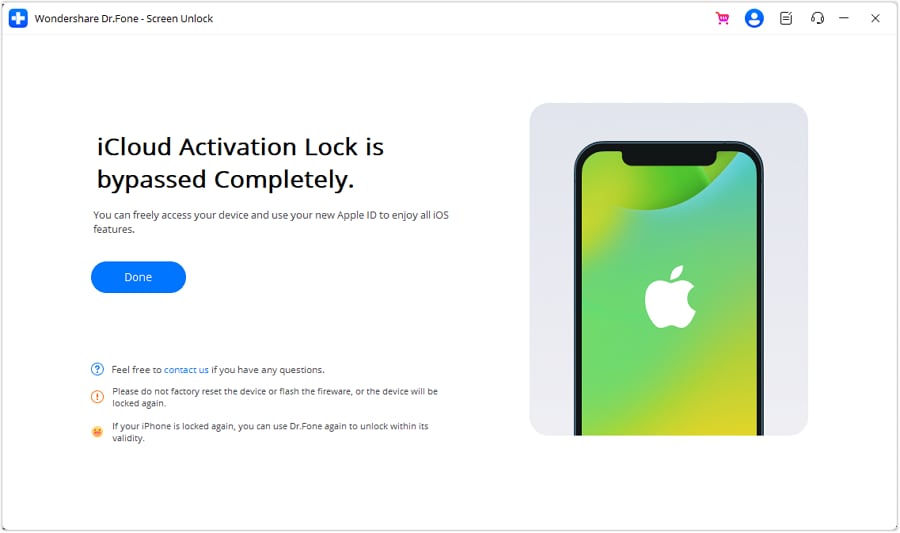
Dr.Fone - Screen Unlock (iOS) simplifies the complex journey of iPhone activation, providing a reliable and efficient alternative. It’s the key to unlocking your device’s full potential when conventional methods fall short. In the next section, you’ll learn how to check if your Apple iPhone 14 has finally been activated.
Bonus: How Do I Know if My iPhone Is Activated?
Wondering if you have resolved your iPhone’s “can’t be activated” issue? Let’s check the clues and ensure your device is ready for action. Here are simple indicators to confirm your Apple iPhone 14’s activation status:

- Check Cellular or Network Connectivity in Settings
Navigate to your Apple iPhone 14’s Settings menu. Head to “Cellular” or “Mobile Data” and ensure it’s switched on. A lit icon signals active connectivity. If using Wi-Fi, look for the Wi-Fi symbol at the top – a strong connection is a green light for activation success.
- Apple ID and iCloud Integration
Activation relies on accurate Apple ID and iCloud details. Confirm these in Settings under “Apple ID” or “iCloud.” Ensure your email and password match the ones used during setup. A synced Apple ID ensures seamless integration, marking your Apple iPhone 14 as officially activated.
- Absence of Activation Prompts
A surefire sign of a successfully activated iPhone is the absence of activation prompts. Once activated, your Apple iPhone 14 should smoothly transition from the initial setup screen to your home screen without any prompts asking for activation details.
Why Does Activation Matter?
Activation is the key to unlocking your Apple iPhone 14’s full potential. It ensures you can make calls, send messages, and enjoy all your device’s features. You can confirm whether your Apple iPhone 14 is activated and ready for action by checking these simple indicators.
Conclusion
In the maze of iPhone activation, you’ve decoded common errors and provided simple fixes. Especially for the ‘iPhone could not be activated’ issue, you now have the solutions to resolve it. And for a fuss-free fix, consider Dr.Fone - Screen Unlock (iOS) – your activation hero.
Swift solutions matter, ensuring you experience your Apple iPhone 14’s full potential. Don’t let activation glitches hinder your Apple iPhone 14 experience; unlock its full potential today! Choose Dr.Fone and embrace seamless activation. Because in the Apple iPhone 14 world, a timely resolution is the key to a smooth digital experience.
Tips: Are you searching for a powerful Screen Unlock tool? No worries as Dr.Fone is here to help you. Download it and start a seamless unlock experience!
Apple iPhone 14 iCloud Activation Lock Bypass
The iCloud lock is an element intended to save your Apple iPhone 14 from missing, getting stolen, or being deleted. So, when you buy an iPhone, register it with an Apple ID, and set “Find My iPhone” to make it iCloud locked. That will make your device more secure.
However, each feature has its cons. It likewise can become problematic if you purchase a second-hand iPhone that is iCloud locked or fail to remember your iCloud details. You might end up staying with an iCloud lock screen. In such cases, you want to open an iCloud-locked device.
Therefore, this article will tell you the best Apple iPhone 14 iCloud bypass techniques. It has both quicker and more permanent solutions to bypass Apple iPhone 14. So, keep following this article until the end to find a permanent solution for your Apple iPhone 14.
Part 1: What is iCloud Activation Lock in iPhone11/12?
The iCloud Activation Lock is a security feature implemented by Apple on Apple iPhone 14 and other iOS devices. It is designed to prevent unauthorized access to the Apple iPhone 14 device by linking it to the owner’s Apple ID and iCloud account. When the Activation Lock is enabled, the Apple iPhone 14 device requires the owner’s Apple ID and password to set up or restore the Apple iPhone 14 device, making it difficult for thieves to use or sell stolen iPhones. The Activation Lock ensures the Apple iPhone 14 device’s data remains secure and can only be accessed by the rightful owner.
Regardless of whether you erase your device, Activation Lock can keep on preventing anybody from reactivating your device without your consent. Regardless of whether your device is stolen, the other person will require either your device password or your Apple ID credentials to use the phone. Even if they try resetting your device through DFU mode, they will not have the option to reactivate and utilize it without Apple iPhone 14 iCloud unlock.
However, it can create a problem for you if you’re the second owner of this device. So, if you bought this phone from someone else, you must remove the lock first. In such cases, you will need Apple iPhone 14 iCloud bypass.
Part 2: How to Bypass Apple iPhone 14 iCloud Activation Lock?
The iCloud Activation Lock is a security feature designed to protect iPhones from unauthorized use. However, if you find yourself with an Apple iPhone 14 locked with iCloud Activation, there are a few methods you can try to bypass the lock. In this article, we will explore three methods: contacting the previous device owner for Apple ID and password, requesting remote removal of the lock, and utilizing the iCloud DNS Bypass method. Let’s dive into each method to help you regain access to your Apple iPhone 14.
Method 1. Contact the Previous Device Owner for Apple ID and Password
The first step in bypassing the iCloud Activation Lock is to reach out to the previous owner of the Apple iPhone 14 and ask for their Apple ID and password. To bypass Apple iPhone 14, you need to have some data in hand:
- Bypassing the activation lock is pretty much easy. However, you need to have the Apple ID credentials of the seller if you’re the second owner.
- If a device doesn’t have the activation lock, you can see the password screen rather than the iCloud lock screen. In that case, ask the old user about the Apple iPhone 14 passcode.
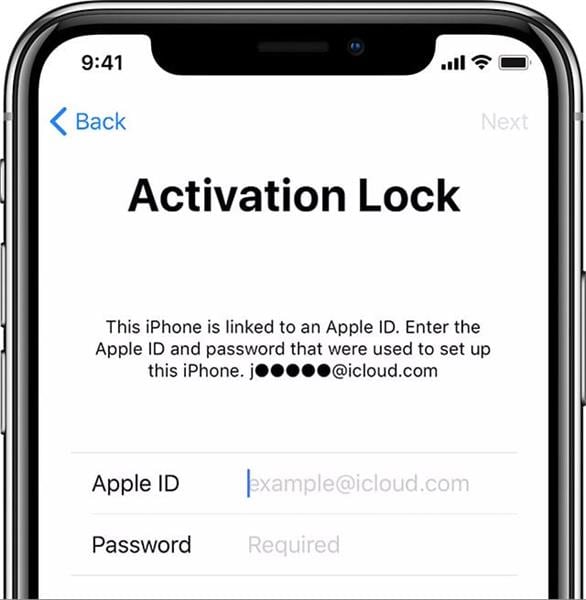
After getting this data, coming up next are the steps to perform Apple iPhone 14 iCloud bypass:
- Step 1: Go to the Settings application on your iDevice.
- Step 2: Tap the Apple ID photo on this window. If the Apple iPhone 14 device has a more up-to-date version of iOS, tap the iCloud option from the menu.
- Step 3: Now click the Sign Out option. You can sign in with your Apple account starting there forward.
- Step 4: Next, look down and click the Sign Out option. When asked, you need to enter the Apple account credentials of the first owner to toggle off the Find My feature.
However, if you see the Apple iPhone 14 passcode, you can type it and set up the Apple iPhone 14 device without the iCloud account.
With the Apple iPhone 14 device set up, access your device’s Settings and sign out of the old ID. You can now make another one and sign into it.
Method 2. Contact the Previous Device Owner to Remove Activation Lock Remotely
If the iPhone’s first owner (seller) has forgotten to do this before selling it to you, it’s time to do it. It would help if you convinced the owner to remove the sold device from their iCloud account. They can even do that remotely by just visiting the iCloud webpage.
However, if they have sold you a stolen iPhone, you may be unable to remove the lock using this technique.
So, if it’s not a stolen device, you don’t need to worry about unlocking it. The owner can remotely control the Apple iPhone 14 device and bypass Apple iPhone 14 by following these steps:
- Step 1: Go to the appleid.apple.com site and sign in with the right iCloud account credentials.
- Step 2: Click the Apple iPhone 14 devices tab to see all the connected iDevices.
- Step 3: Pick your Apple iPhone 14 model from there.
- Step 4: Then, click Erase from Account to get it unlocked. It’s as simple as that.
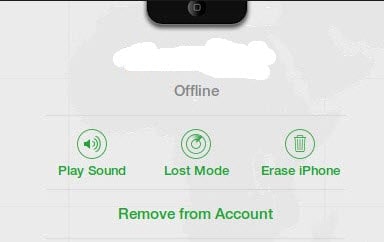
Method 3. Use iCloud DNS Bypass
The third method involves using iCloud DNS Bypass, a technique that exploits a loophole in the iCloud Activation Lock system. iCloud DNS bypass is a temporary technique to access an iCloud-locked device’s features. DNS interprets your domains into IP addresses. After keying in a domain name, your DNS server takes you to that specific IP address on the internet. When you attempt to activate your Apple iPhone 14, your device connects with the DNS and the Mac servers. Someway, you can key in some domain name servers here, and they will take your device to that server.
How Can iCloud DNS Bypass Help You?
A DNS bypass can do plenty of things for you. You can unlock your device with it. When the Apple iPhone 14 device unlocks, you can access applications internet and work smoothly on your costly device. It opens up most features of your Apple iPhone 14.
Limitations of this Features
When you use other ways to unlock the iCloud lock, it completely gets removed from your device, and you can utilize each feature. Unfortunately, that isn’t true with an iCloud DNS bypass server. If you utilize this technique, you can access specific features.
The steps in DNS Bypass iCloud Activation are very straightforward; here are the steps.
- Step 1: When you switch on your device, pick your LANGUAGE and COUNTRY from the menu.
- Step 2. Click “Proceed” to enter the Wi-Fi settings page. Whenever requested to connect with Wi-Fi, search for the “I” icon near the Wi-Fi tab.
- Step 3. Disconnect the Wi-Fi, go to “Connection Settings,” and snap “Forget this Network.”
- Step 4. Click the “I” icon and enter a DNS server IP address. You can browse the IP addresses below:
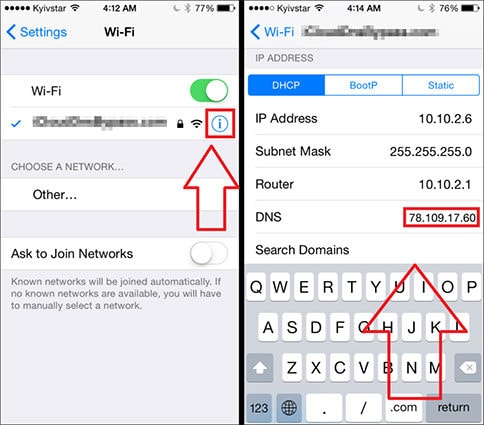
USA: 104.154.51.7
South America: 35.199.88.219
Europe: 104.155.28.90
Asia: 104.155.220.58
Australia and Oceania: 35.189.47.23
Other regions: 78.100.17.60
Step 5. Presently, click the “Back” choice on the left half of your screen, turn on Wi-Fi, select your network from there, and enter your code.
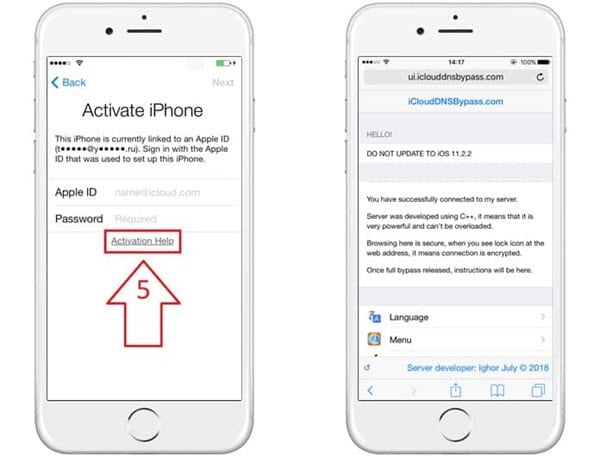
- Step 6. Click “Next Page” and snap “Back” to enter the iCloud bypass screen.
- Step 7. Your device will unlock, and you can access all its features now.
Bonus Tip: Bypass iCloud Activation Lock quickly with Dr.Fone - Screen Unlock (For iPhone 5S to iPhone X/SE 1 running iOS 12.0 to iOS 16.6)
Because of the limitations of iCloud DNS bypass and the cons of the other mentioned ways, many people tend to find a permanent solution to their issue. Therefore, we suggest you get an advanced tool to examine this matter.
Many tools are available online; however, recommending the best one is our responsibility. Therefore, we strongly advocate for Dr.Fone. Dr.Fone - Screen Unlock by Wondershare gives you a complete solution. But note that this Apple activation lock removal tool is for iPhone 5S to iPhone X/SE 1, iPad 4 to iPad 7, and iPod touch 7 to iPod touch 9 running iOS 12.0 to iOS 16.6.
It is an all-in-one iOS unlocking program that can assist you with iPhone iCloud unlock without an Apple account. It enables you to use your phone like a default one. It is portrayed as quick, straightforward, and reliable. Whether you get a second-hand iPhone trapped in the iCloud lock or don’t know about the Apple account, you can use this program to bypass iPhone 5s to iPhone X/SE 1.
Step-by-Step guide:
Step 1. Install the Dr.Fone program on your PC and choose the Screen Unlock tool. You will see “iCloud Activation Lock Removal” as the following picture shows.

Step 2. Begin your bypass process with this “Start” button interface.

Step 3. Jailbreak is the final and necessary step to finally bypass the activation lock on your Apple iPhone 14.

Step 4. When you see the progress bar moving, it means the activation lock will no longer exist on your Apple iPhone 14.

The whole process will remove the activation lock in a moment or two. Presently, your Apple iPhone 14 will have no lock. You can access and utilize the Apple iPhone 14 now.
The Bottom Line
Getting locked on the activation lock screen can be hectic and time-consuming if you don’t know what to do. Many of you might quit trying after surfing the internet for a solution and getting technical answers from inexperienced individuals. Therefore, we gathered this Apple iPhone 14 iCloud bypass guide to help you understand the situation better.
Once you understand the issue, you can unlock it in minutes using Dr.Fone - Screen Unlock (iOS) by Wondershare. So don’t wait for a godly miracle to happen, and download Dr.Fone for a permanent answer to your queries.
Also read:
- [New] Real-Time Visualizer for 2024
- [Updated] Crafting Compelling TikTok Tweets for Engagement for 2024
- [Updated] Efficient Techniques for Blurring Unwanted Edges for 2024
- [Updated] In 2024, Innovative YouTube Titles Crafting a Standout Brand
- Bypass iCloud Activation Lock with IMEI Code From iPhone 13
- CS:Global Offensive Audio Problems? How to Repair In-Game Microphone Malfunctions
- How to jailbreak iCloud locked iPhone 8
- In 2024, How To Bypass iCloud By Checkra1n Even On Apple iPhone 7 If Youve Tried Everything
- In 2024, The Best Android SIM Unlock Code Generators Unlock Your Huawei Nova Y91 Phone Hassle-Free
- In 2024, Ultimate Guide on iPhone 13 iCloud Activation Lock Bypass
- Title: New Multiple Ways How To Remove iCloud Activation Lock On your iPhone 14
- Author: Lydia
- Created at : 2024-10-14 16:53:44
- Updated at : 2024-10-20 17:40:36
- Link: https://activate-lock.techidaily.com/new-multiple-ways-how-to-remove-icloud-activation-lock-on-your-iphone-14-by-drfone-ios/
- License: This work is licensed under CC BY-NC-SA 4.0.